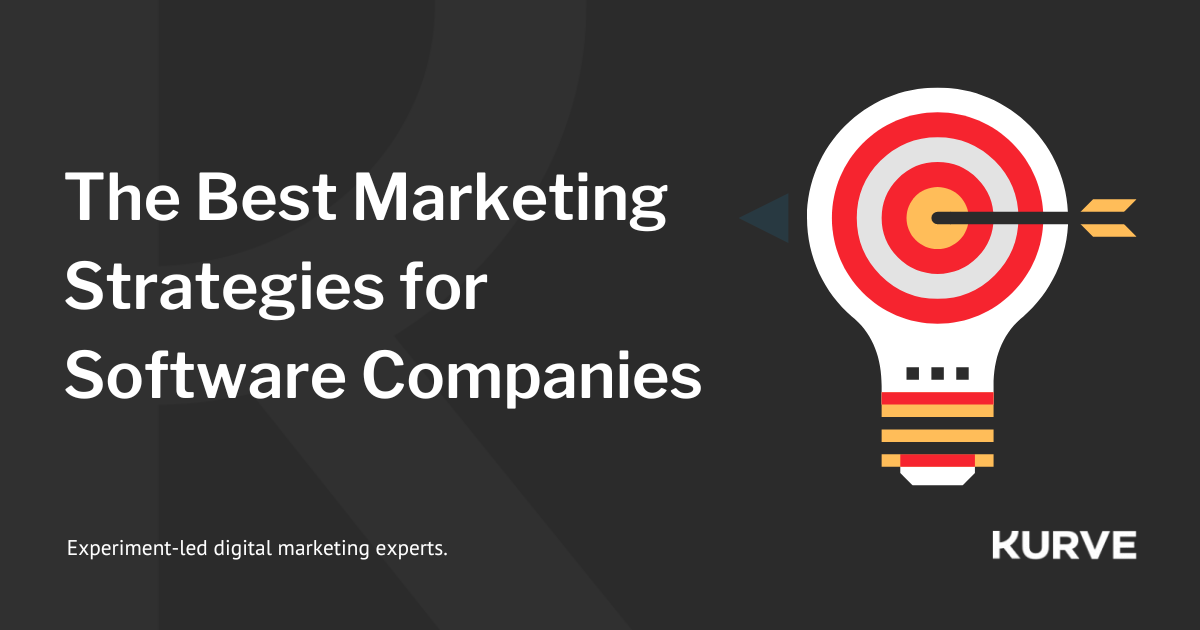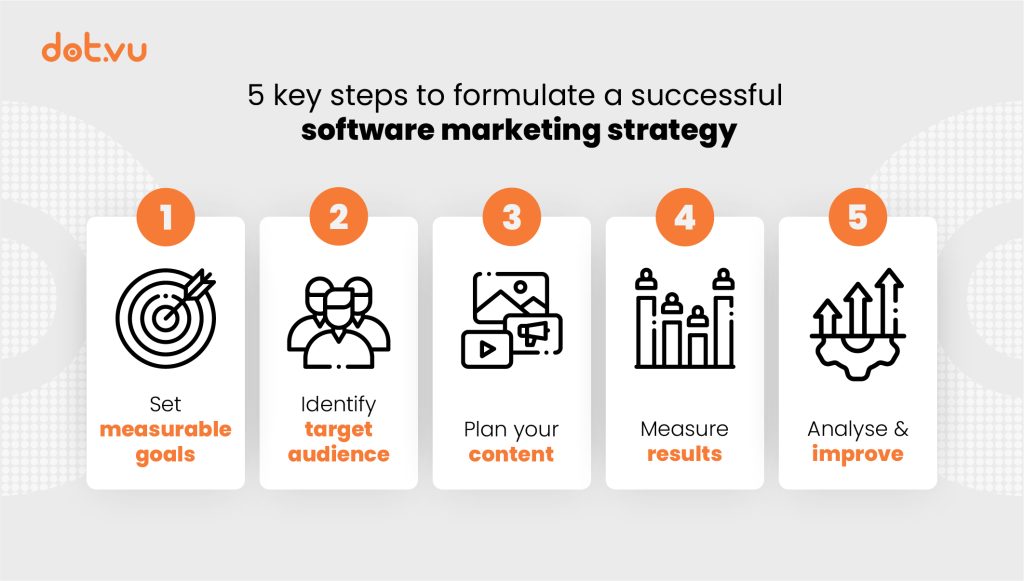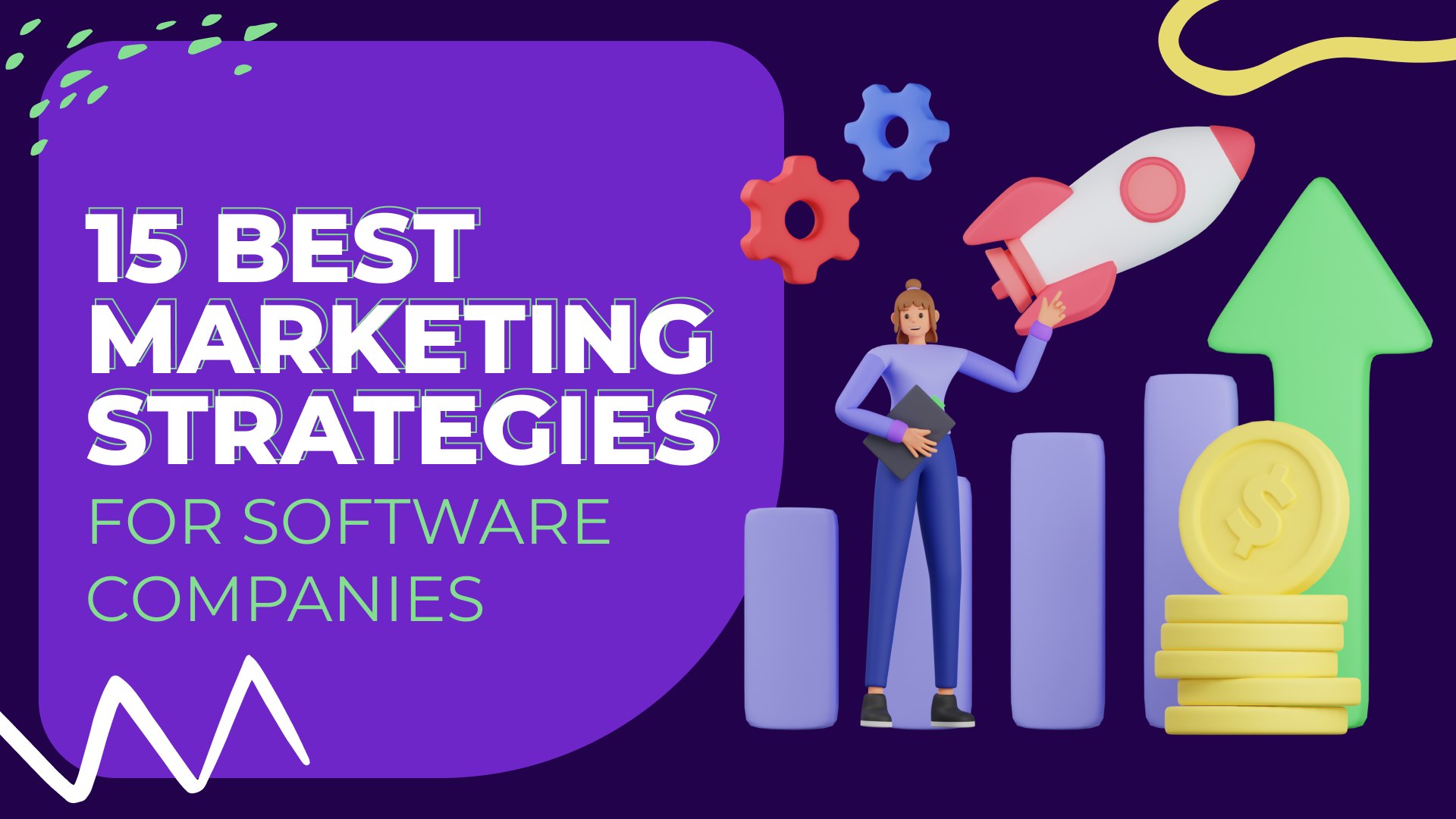A software marketing strategy involves promoting software products to the target audience using various digital channels. It aims to increase visibility and drive user adoption.
Crafting an effective software marketing strategy requires understanding your target audience and their needs. Identify the unique selling points of your software and highlight them in your marketing materials. Use SEO techniques to enhance online visibility and attract organic traffic.
Leverage content marketing to educate potential users about the benefits and features of your software. Social media platforms can help engage with your audience and build a community around your product. Email marketing is effective for nurturing leads and maintaining customer relationships. Regularly analyze your marketing efforts to optimize and refine your strategy for better results.

Credit: kurve.co.uk
Market Research
Effective market research is crucial for any successful software marketing strategy. It helps understand the market, identify trends, and analyze competitors. This insight can guide your decisions and improve your marketing efforts.
Identifying Trends
Identifying trends involves staying updated with industry developments. This can reveal what customers want and need. Use tools like Google Trends and social media analytics. These can provide insights into emerging topics and interests.
Keep an eye on industry reports and publications. Subscribe to newsletters from industry leaders. Attend webinars and conferences to stay ahead.
Analyzing Competitors
Analyzing competitors helps you understand their strengths and weaknesses. Use this information to improve your offerings. Tools like SEMrush and Ahrefs can help with this analysis.
Create a table to compare key features and pricing:
| Competitor | Features | Pricing | Strengths | Weaknesses |
|---|---|---|---|---|
| Competitor A | Feature 1, Feature 2 | $$$ | Strong Support | Limited Integrations |
| Competitor B | Feature 3, Feature 4 | $$ | Good UI | High Cost |
Pay attention to user reviews on platforms like G2 Crowd and Capterra. These reviews can offer insights into user satisfaction and common issues.

Credit: ninjapromo.io
Target Audience
Understanding your target audience is the cornerstone of any successful software marketing strategy. Knowing who will use your software helps you tailor your messaging and approach. This ensures you reach and engage the right people effectively.
Defining Personas
Creating buyer personas involves identifying the characteristics of your ideal users. These personas are semi-fictional representations based on real data and market research. Here are some key elements to include:
- Demographics: Age, gender, education, and income.
- Job Role: Titles, responsibilities, and industry.
- Goals: What they aim to achieve using your software.
- Challenges: Problems your software can solve for them.
- Behavior: How they interact with technology and make decisions.
Defining these personas helps you create targeted marketing campaigns. It also helps in crafting messages that resonate with your audience.
Segmenting Users
Once you have your personas, the next step is user segmentation. This involves dividing your audience into smaller, more specific groups. Segmentation allows you to personalize your marketing efforts.
Here are some common ways to segment users:
- By Demographics: Age, gender, location.
- By Behavior: Purchase history, website interactions.
- By Needs: Specific features or solutions they seek.
- By Engagement Level: Active users vs. inactive users.
Let’s look at a simple table to summarize:
| Segmentation Type | Examples |
|---|---|
| By Demographics | Age, Gender, Location |
| By Behavior | Purchase History, Website Interactions |
| By Needs | Specific Features, Solutions |
| By Engagement Level | Active Users, Inactive Users |
Segmentation helps you deliver the right message to the right audience. It increases engagement and conversion rates.
Brand Positioning
Brand positioning is vital in software marketing. It defines your place in the market. Effective positioning sets your software apart. It helps customers understand your unique value. Clear positioning can drive customer loyalty and trust.
Crafting Unique Value
Crafting unique value is the first step. Understand what makes your software special. Identify key features and benefits.
- User-friendly interface
- Advanced security features
- Seamless integration
Highlight these in your messaging. Use simple, clear language. Avoid technical jargon. Make it easy for all to understand.
Differentiating From Competitors
Differentiating from competitors is essential. Study your competition. Identify their strengths and weaknesses. Create a comparison table to visualize differences.
| Feature | Your Software | Competitor A | Competitor B |
|---|---|---|---|
| Price | $50/month | $60/month | $55/month |
| Customer Support | 24/7 Support | Business Hours | 24/7 Support |
| Unique Features | AI Integration | Basic Tools | Advanced Analytics |
Use these insights to position your software. Emphasize your strengths. Address your competitors’ weaknesses. This makes your brand stand out.

Credit: blog.dot.vu
Content Marketing
Content Marketing is a crucial aspect of a successful Software Marketing Strategy. It helps in building brand awareness, driving traffic, and converting leads. By creating valuable content, you can engage your audience and establish your authority in the software industry.
Creating Engaging Content
Engaging content is key to capturing your audience’s attention. Start by understanding your target audience. Know their needs, preferences, and pain points. Create content that addresses these aspects.
Use a mix of formats to keep your content diverse:
- Blog Posts: Write informative and engaging articles.
- Videos: Produce tutorials, demos, and customer testimonials.
- Infographics: Use visuals to simplify complex information.
- eBooks: Offer in-depth guides and resources.
Make sure your content is well-researched, original, and provides real value. Always include a clear call-to-action to guide your readers on the next steps.
Seo Best Practices
Search Engine Optimization (SEO) is crucial for your content to rank high on search engines. Follow these best practices to improve your SEO:
- Keyword Research: Identify relevant keywords for your niche.
- On-Page SEO: Use keywords in titles, headings, and meta descriptions.
- Quality Content: Write high-quality, informative content.
- Internal Linking: Link to other relevant pages on your website.
- Backlinks: Earn links from reputable sites.
Use tools like Google Analytics to track your content’s performance. Adjust your strategy based on data and trends.
Social Media
Social media is a powerful tool in software marketing strategy. It allows businesses to reach a wide audience. Through social media, companies can engage directly with users. This section will discuss key aspects of social media marketing.
Platform Selection
Choosing the right platform is crucial. Each social media platform has its own audience. Here are some popular platforms:
| Platform | Audience | Best For |
|---|---|---|
| Wide age range, global | Brand awareness, customer interaction | |
| Professionals, B2B | Networking, industry news | |
| Younger audience, visual content | Product showcases, brand personality | |
| Real-time updates, diverse | Customer service, news sharing |
Use these insights to choose the best platform for your software. This ensures your marketing efforts are effective.
Engagement Strategies
Engagement is key on social media. Here are some strategies to boost engagement:
- Post consistently: Regular updates keep your audience engaged.
- Use visuals: Images and videos attract more attention.
- Ask questions: Encourage your audience to interact with posts.
- Respond promptly: Quick replies build trust with your audience.
- Run contests: Contests and giveaways increase participation.
Consistent and engaging content helps build a loyal audience. This, in turn, enhances your software’s visibility and reputation.
Email Campaigns
Email campaigns are a powerful tool in software marketing strategies. They help businesses connect directly with their audience. Effective email campaigns can boost user engagement and drive conversions.
Personalization Techniques
Personalization techniques in email marketing can make a huge difference. Personalized emails create a unique experience for the user. Here are some effective personalization techniques:
- Use the recipient’s name: Addressing the recipient by name creates a personal touch.
- Segment your audience: Group your audience based on their preferences and behaviors.
- Custom subject lines: Tailor your subject lines to grab attention quickly.
- Dynamic content: Use dynamic content to show relevant information for each user.
Personalization can increase open rates and improve user engagement.
A/b Testing
A/B testing is essential for optimizing email campaigns. It involves sending two versions of an email to see which performs better. Here are steps to conduct effective A/B testing:
- Identify the variable: Choose one element to test, such as subject line or call-to-action.
- Create two versions: Develop two versions of the email with slight differences.
- Split your audience: Divide your audience into two groups randomly.
- Send the emails: Send each version to the respective group.
- Analyze the results: Compare metrics like open rate and click-through rate.
By consistently A/B testing, you can refine your email campaigns for better results.
Paid Advertising
Paid advertising is crucial in a software marketing strategy. It helps reach a larger audience quickly. Different ad formats and budget management are key components. Let’s explore these aspects in detail.
Ad Formats
Choosing the right ad format is vital. It ensures your message reaches the right audience. Here are some popular ad formats:
- Search Ads: Appear on search engine results pages.
- Display Ads: Shown on websites as banners or images.
- Social Media Ads: Visible on platforms like Facebook and Instagram.
- Video Ads: Found on platforms like YouTube.
Each ad format serves a different purpose. Select the one that aligns with your goals. For example, use search ads to capture high-intent users. Use social media ads for brand awareness.
Budget Management
Effective budget management ensures maximum ROI. Allocate your budget wisely across different channels. Here are some tips:
- Set a clear budget for each ad campaign.
- Monitor ad performance regularly.
- Adjust budget based on performance data.
Use tools like Google Ads to track spending. Identify which ad formats yield the best results. Focus your budget on high-performing ads. Avoid overspending on low-performing campaigns.
Here’s a simple table to help allocate your ad budget:
| Ad Format | Budget Allocation (%) |
|---|---|
| Search Ads | 40% |
| Display Ads | 20% |
| Social Media Ads | 30% |
| Video Ads | 10% |
Regularly review your budget allocation. Make adjustments to optimize your ad spend. Effective budget management leads to better results.
Analytics
Analytics play a crucial role in a Software Marketing Strategy. They help you understand your audience better. Tracking the right data is essential for success. This section will cover key metrics and performance tracking.
Key Metrics
Key metrics are vital to measure your software marketing success. Focus on these specific metrics:
- Customer Acquisition Cost (CAC): The cost to acquire a new customer.
- Customer Lifetime Value (CLV): The total revenue from a customer over time.
- Conversion Rate: The percentage of visitors who become customers.
- Churn Rate: The percentage of customers who stop using your software.
- Return on Investment (ROI): The profit generated from your marketing efforts.
Performance Tracking
Performance tracking helps you understand the effectiveness of your strategies. Use these tools and methods:
| Tool | Purpose |
|---|---|
| Google Analytics | Tracks website traffic and user behavior. |
| SEMrush | Analyzes SEO performance and competitor data. |
| HubSpot | Manages and tracks inbound marketing efforts. |
| Mixpanel | Monitors product usage and user engagement. |
Regularly review your performance data. Adjust your strategy based on insights. Focus on metrics that align with your business goals. Use A/B testing to refine your campaigns.
- Identify your key metrics.
- Choose the right tools for tracking.
- Analyze the data regularly.
- Make data-driven decisions.
- Continuously optimize your strategy.
Effective analytics can transform your software marketing strategy. It leads to better results and higher ROI.
Customer Feedback
Customer Feedback is a cornerstone of an effective software marketing strategy. Gathering insights and implementing changes based on user feedback can drive your product’s success. Below, we explore how to gather insights and implement changes effectively.
Gathering Insights
To improve your software, start by gathering insights from users. Use various methods to collect valuable feedback:
- Surveys: Create short, simple surveys. Ask specific questions about user experience.
- User Interviews: Conduct one-on-one interviews. Gain in-depth understanding of user needs.
- Social Media: Monitor social media channels. Track mentions and user sentiments.
- Feedback Forms: Integrate feedback forms in your software. Allow users to submit suggestions directly.
- Analytics Tools: Use tools like Google Analytics. Analyze user behavior and patterns.
Implementing Changes
After gathering insights, focus on implementing changes to enhance your software:
- Prioritize Feedback: Identify the most critical issues. Address them first.
- Develop a Plan: Create a step-by-step plan. Include timelines and responsible teams.
- Test Changes: Implement changes in stages. Test each update thoroughly before a full release.
- Communicate Updates: Inform users about changes. Use newsletters, blog posts, and in-app notifications.
- Monitor Results: Track the impact of changes. Continue to gather feedback for ongoing improvements.
Using these strategies, you can build a user-focused software product. This will lead to higher user satisfaction and loyalty.
Future Trends
The world of software marketing is changing rapidly. Staying ahead requires understanding future trends. Let’s explore some key areas that will shape software marketing strategies.
Emerging Technologies
Emerging technologies are transforming how software is marketed. Artificial Intelligence (AI), Machine Learning (ML), and Blockchain are some examples.
AI and ML help analyze customer data. They personalize marketing campaigns based on user behavior. This boosts engagement and conversion rates.
Blockchain technology ensures secure and transparent transactions. It builds trust among users and enhances brand reputation.
Here is a table showing key technologies and their benefits:
| Technology | Benefits |
|---|---|
| Artificial Intelligence | Personalized marketing, better customer insights |
| Machine Learning | Predictive analytics, improved customer experience |
| Blockchain | Secure transactions, increased trust |
Adapting Strategies
Adapting strategies is crucial in the evolving landscape. Here are some tips:
- Use data-driven insights to make informed decisions.
- Embrace social media to reach a wider audience.
- Focus on mobile marketing as more users go mobile.
- Leverage content marketing to educate and engage customers.
- Implement SEO best practices to improve visibility.
Staying flexible and open to new approaches is key. Marketing strategies must evolve with changing trends and technologies.
Frequently Asked Questions
What Is Software Marketing Strategy?
A software marketing strategy is a plan to promote and sell software products. It includes market research, target audience identification, and promotional tactics.
Why Is Software Marketing Important?
Software marketing is important to reach potential customers, increase sales, and build brand awareness. It helps in staying competitive in the market.
How To Identify Target Audience?
To identify the target audience, analyze market data, user behavior, and demographics. Understand their needs and preferences to tailor your marketing efforts effectively.
What Are Effective Software Marketing Channels?
Effective software marketing channels include social media, email marketing, content marketing, and SEO. Each channel helps reach different segments of your audience.
Conclusion
Crafting a robust software marketing strategy ensures success in a competitive market. Focus on understanding your audience and leveraging data. Implement targeted campaigns and continuously optimize based on feedback. A well-executed strategy drives growth and builds brand loyalty. Stay adaptable and keep refining your approach for the best results.
